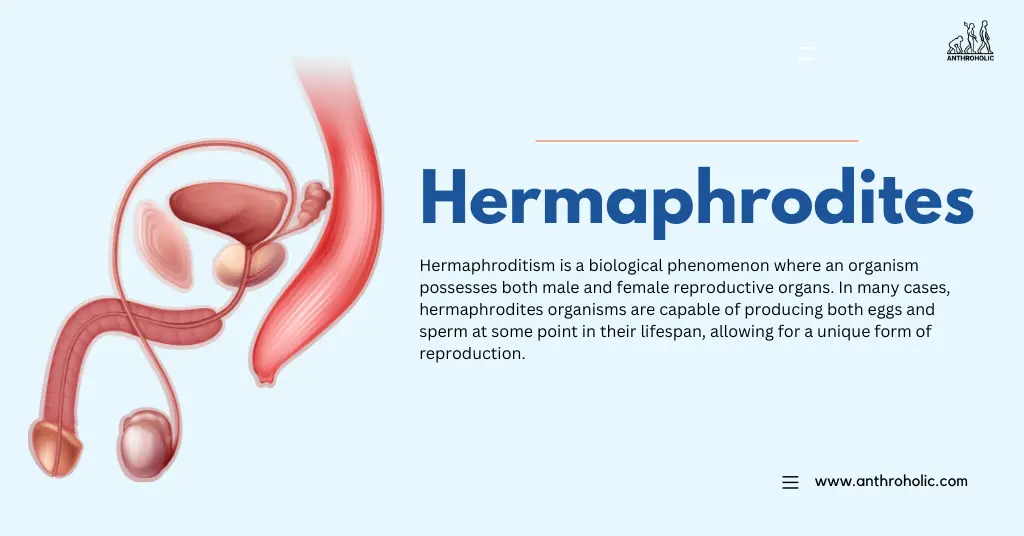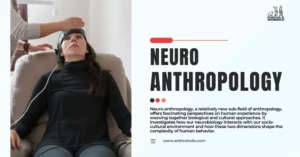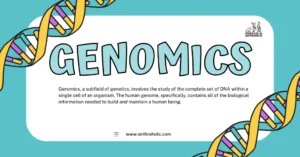Hermaphrodites
Hermaphroditism is a biological phenomenon where an organism possesses both male and female reproductive organs. In many cases, hermaphrodites organisms are capable of producing both eggs and sperm at some point in their lifespan, allowing for a unique form of reproduction. The term originates from Greek mythology, where Hermaphroditus, the child of Hermes and Aphrodite, possessed both male and female attributes [1].

Hermaphrodites in Different Species
Hermaphroditism is widespread among animals and plants, but the extent and mechanisms of its expression can vary widely across different species.
In the animal kingdom, hermaphroditism is most commonly seen in invertebrates, such as snails, slugs, and worms, where it allows for increased flexibility in reproduction [1]. For instance, earthworms are simultaneous hermaphrodites, possessing both male and female reproductive organs and are capable of self-fertilization [2].
In the world of fish, hermaphroditism is also not uncommon. Many species of fish, such as wrasses and clownfish, are sequential hermaphrodites, meaning they switch sex at some point in their lifetime. This ability allows them to maximize reproductive success based on environmental and social conditions [3].
Among plants, hermaphroditism is the norm rather than the exception. Most flowering plants, or angiosperms, are hermaphrodites, bearing both male (stamens) and female (pistil) parts within the same flower. This facilitates a variety of pollination strategies, including self-fertilization when cross-pollination is not possible [4].
Hermaphroditism in Nature
Sequential Hermaphrodites
Sequential hermaphrodites are species that change sex at some point in their life. This characteristic can be found in many species of fish, mollusks, and some plants.
- Protogynous (Female to Male): Protogyny is a type of sequential hermaphroditism where an organism starts its life as a female and later transitions into a male. This pattern is prevalent in many species of fish, such as wrasses and parrotfish. These species usually live in harems with one dominant male and multiple females. If the male dies, the largest female changes sex and takes his place [3].
- Protandrous (Male to Female): Protandry, in contrast, is a type of sequential hermaphroditism where an organism starts life as a male and later changes into a female. This is common among many species of fish, including clownfish. In a clownfish group, there is a dominant female and subordinate males. If the female dies, the dominant male will change sex and become female [4].
- Simultaneous Hermaphrodites: Simultaneous hermaphrodites are species that possess both male and female reproductive organs at the same time. This is commonly found in many invertebrates, such as snails, slugs, and earthworms. These species are capable of self-fertilization, but usually prefer cross-fertilization when partners are available [1].
Evolutionary Advantage of Hermaphroditism
Hermaphroditism offers several evolutionary advantages. For species in isolated or sparse populations, hermaphroditism ensures that any encounter with another member of the same species can potentially lead to reproduction, maximizing the chances of passing on genes. In environments with fluctuating conditions, the ability to change sex allows organisms to maximize their reproductive success based on the availability of resources or mates [5].
Biological Processes Behind Gender Change
- The process of gender change in sequential hermaphrodites is often a complex transformation that involves remodeling of the gonads and changes in secondary sexual characteristics.
- For example, in protogynous wrasses, the process involves the degeneration of ovarian tissue and the proliferation of testicular tissue.
- In contrast, protandrous clownfish experience the cessation of spermatogenesis and the initiation of oogenesis, often triggered by social cues such as the removal of the dominant female from the group.
- Molecular mechanisms underlying sex change are not yet fully understood, but research suggests they involve complex genetic and hormonal networks.
- In clownfish, for instance, research has shown that sex change is accompanied by differential expression of various genes, including those involved in steroid hormone synthesis and signaling, suggesting that hormones play a key role in this process.
Genetic and Environmental Factors
- Both genetic and environmental factors play a role in hermaphroditism.
- For example, in some simultaneous hermaphrodites such as snails, the capacity for self-fertilization may be influenced by the presence of specific alleles.
- In terms of environmental factors, sequential hermaphrodites often rely on external cues to trigger sex change.
- These can be social cues, such as changes in the composition of the population, or environmental cues, such as changes in temperature or food availability.
- Research into the genetic and environmental triggers of hermaphroditism continues, and our understanding of this fascinating phenomenon is likely to grow in the future.
Intersex Conditions and Hermaphroditism
Intersex is a general term used for a variety of conditions in which a person is born with reproductive or sexual anatomy that doesn’t seem to fit the typical definitions of female or male. Hermaphroditism is one of many intersex variations.
- True Hermaphroditism: True hermaphroditism, also known as ovotesticular disorder, is a rare intersex condition in which an individual has both ovarian and testicular tissue. This can be in the form of one ovary and one testis, or as two ovotestes. Typically, physical appearance varies from clearly male or female to more ambiguous forms.
- Pseudohermaphroditism: Pseudohermaphroditism is a condition where an individual has the gonads of one sex, but the physical characteristics of the other sex. This can be categorized further into male and female pseudohermaphroditism. Male pseudohermaphroditism refers to individuals with testes but female secondary sexual characteristics, while female pseudohermaphroditism refers to individuals with ovaries but male secondary sexual characteristics.
Diagnosing and Treating Intersex Conditions
- Diagnosis of intersex conditions can sometimes occur at birth due to ambiguous genitalia, but in other cases, diagnosis may not occur until puberty or later. It typically involves a combination of physical examination, medical history, hormone tests, genetic tests, and imaging tests.
- Management of intersex conditions often requires a multidisciplinary approach that takes into account physical health, mental health, and the individual’s own perception of their gender identity. Treatment options may include hormone therapy, surgery, psychological counseling, and support groups.
Ethical Concerns in Intersex Medicine
There are significant ethical issues surrounding the medical treatment of intersex conditions. Historically, many intersex individuals were subjected to surgeries during infancy or childhood intended to “normalize” their physical appearance. However, these surgeries have been criticized for potentially causing harm, including loss of sexual function, psychological distress, and violations of personal autonomy.
More recently, there has been a shift towards delaying unnecessary surgeries until the individual can participate in decisions about their own body. This is in line with an emphasis on patient autonomy, informed consent, and respect for individuals’ rights to their own gender identity.
Modern Perception and Representation in Media
Public perception of hermaphroditism and intersex conditions has evolved significantly in recent years, largely due to increased representation and awareness in the media. Previously, intersex conditions were often misunderstood or stigmatized, but there is growing recognition of the diversity of human sex characteristics and gender identities.
In modern media, intersex individuals are increasingly portrayed in a more sensitive and nuanced manner. This shift has been facilitated by advocacy groups and the voices of intersex individuals themselves who share their experiences and work towards improving understanding and acceptance.
Documentaries, films, and TV series such as the critically acclaimed series “Faking It” have depicted intersex characters and their stories, broadening public awareness. Similarly, news articles and digital media platforms have been used to share personal stories, medical insights, and ethical discussions regarding intersex issues.
There’s a growing advocacy for media literacy, in particular, the need to critically engage with media representations of intersex individuals. In other words, audiences should be educated to understand, analyze, evaluate, and create media in a variety of forms.
Summarizing the Importance of Understanding Hermaphroditism
Understanding hermaphroditism is crucial for several reasons, spanning across various fields from biology to social sciences, and medicine to ethics.
In the realm of biology, hermaphroditism offers valuable insights into the diversity and adaptability of life. This phenomenon has evolved in many species as a reproductive strategy, providing an interesting subject for evolutionary biologists. Furthermore, studying the mechanisms behind sex change in sequential hermaphrodites contributes to our understanding of genetics, endocrinology, and developmental biology.
Moreover, understanding hermaphroditism is essential from a societal and ethical perspective. Intersex individuals, who may have characteristics of hermaphroditism, have historically faced stigma, discrimination, and unnecessary medical procedures. Awareness and understanding of hermaphroditism can help foster acceptance, respect, and equal rights for intersex people. Furthermore, it challenges binary notions of sex and gender, thereby enriching our understanding of human diversity.
In conclusion, understanding hermaphroditism holds significant implications for biology, medicine, society, ethics, and media. It promotes scientific knowledge, improves healthcare, fosters acceptance and respect, and contributes to a more comprehensive understanding of the spectrum of human diversity.
FAQs about Hermaphrodites
References
[1] Leonhardt, K., Theis, A., Higham, J. P., & Stevens, M. (2019). Bioluminescent signals are spatially amplified by wavelength-specific diffusion through the shell of a marine snail. Proceedings of the Royal Society B, 286(1897), 20182563. https://doi.org/10.1098/rspb.2010.2203
[2] Sakakura, Y., Soyano, K., Noakes, D. L., & Hagiwara, A. (2005). Gonadal morphology in the self-fertilizing mangrove killifish, Kryptolebias marmoratus. Ichthyological Research, 52(4), 367-371.
[3] Munday, P. L., Buston, P. M., & Warner, R. R. (2006). Diversity and flexibility of sex-change strategies in animals. Trends in Ecology & Evolution, 21(2), 89-95.
[4] Barrett, S. C. (2002). The evolution of plant sexual diversity. Nature Reviews Genetics, 3(4), 274-284.
[5] Godwin, J. (2009). Social determination of sex in reef fishes. Seminars in Cell & Developmental Biology, 20(3), 264-270.
[6] Warner, R. R. (1975). The adaptive significance of sequential hermaphroditism in animals. The American Naturalist, 109(967), 61-82.




